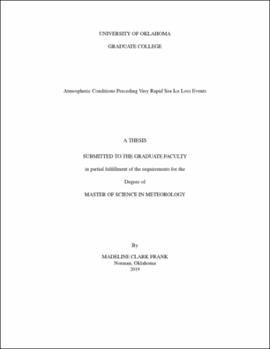| dc.contributor.advisor | Cavallo, Steven | |
| dc.contributor.author | Frank, Madeline Clark | |
| dc.date.accessioned | 2019-05-13T17:53:53Z | |
| dc.date.available | 2019-05-13T17:53:53Z | |
| dc.date.issued | 2019 | |
| dc.identifier.uri | https://hdl.handle.net/11244/319734 | |
| dc.description.abstract | Even though the observed amplified warming trend in the Arctic region is well-established in theory through climate feedbacks and reproduced in global climate model projections, the same global climate models underestimate the corresponding decline in Arctic sea ice extent. Even some of the most sophisticated global climate models do not reproduce the observed characteristics or trends in present day Arctic cyclones. These results would indicate that a deeper understanding of the ocean-atmosphere interface is critical to improving both forecasting and analysis of stronger storms – systems that have the potential to both interfere with maritime transport and act to increase sea-ice loss. Periods of significant sea ice loss have been observed in conjunction with extreme cyclones during the summer, such as the “Great Arctic Cyclone” in August 2012. We refer to such sea ice loss events that occur over a few days as very rapid sea ice loss events. The goals of this thesis are two fold: 1.) To establish that a relationship between Tropopause Polar Vortices, surface cyclones, and very rapid sea ice loss events (VRILEs) exists and 2.) To characterize what atmospheric and sea ice conditions are ideal for VRILEs to occur. We hypothesize that long-lived Arctic cyclones located over thin ice have the greatest impact on sea ice loss.
After identifying the time and location of the VRILEs using sea ice extent and concentration data from the National Snow and Ice Data Center, we composite cases separately for summer (JJA) and winter (DJF) events. Results show that on average during the summer, very rapid sea ice loss events occur in a region of particularly strong pressure gradient between an Arctic cyclone and high pressure over the Beaufort Sea. During winter, very rapid sea ice loss events occur when the pressure gradient region of cyclones entering the Arctic from midlatitude storm tracks is strong over the marginal ice zones. Composites further reveal the presence of a tropopause polar vortex located above the Arctic cyclone but exhibiting a slight vertical tilt at the time of the ice loss event. Comparisons of Arctic cyclones associated with very rapid ice loss events from those that are not reveal that cyclone lifetime, radius, and speed are statistically significant properties but minimum mslp is not. | en_US |
| dc.language | en_US | en_US |
| dc.subject | Arctic sea ice | en_US |
| dc.subject | surface cyclones | en_US |
| dc.subject | sea ice atmosphere interaction | en_US |
| dc.title | Atmospheric Conditions Preceeding Very Rapid Sea Ice Loss Events | en_US |
| dc.contributor.committeeMember | Parsons, David | |
| dc.contributor.committeeMember | Furtado, Jason C. | |
| dc.date.manuscript | 2019-05-10 | |
| dc.thesis.degree | Master of Science in Meteorology | en_US |
| ou.group | College of Atmospheric and Geographic Sciences::School of Meteorology | en_US |
